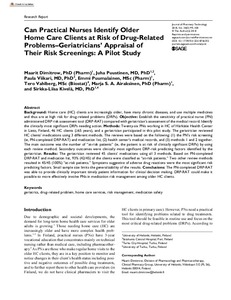Can Practical Nurses Identify Older Home Care Clients at Risk of Drug-Related Problems-Geriatricians' Appraisal of Their Risk Screenings: A Pilot Study
Dimitrow M; Viikari P; Airaksinen MSA; Puumalainen E; Kivelä SL; Puustinen J; Vahlberg T
Can Practical Nurses Identify Older Home Care Clients at Risk of Drug-Related Problems-Geriatricians' Appraisal of Their Risk Screenings: A Pilot Study
Dimitrow M
Viikari P
Airaksinen MSA
Puumalainen E
Kivelä SL
Puustinen J
Vahlberg T
SAGE PUBLICATIONS INC
Julkaisun pysyvä osoite on:
https://urn.fi/URN:NBN:fi-fe2021042719207
https://urn.fi/URN:NBN:fi-fe2021042719207
Tiivistelmä
Background: Home care (HC) clients are increasingly older, have many chronic diseases, and use multiple medicines and thus are at high risk for drug-related problems (DRPs). Objective: Establish the sensitivity of practical nurse (PN) administered DRP risk assessment tool (DRP-RAT) compared with geriatrician's assessment of the medical record. Identify the clinically most significant DRPs needing action. Methods: Twenty-six PNs working in HC of Harkatie Health Center in Lieto, Finland, 46 HC clients (>= 65 years), and a geriatrician participated in this pilot study. The geriatrician reviewed HC clients' medications using 3 different methods. The reviews were based on the following: (1) the PN's risk screening (ie, PN-completed DRP-RAT) and medication list, (2) health center's medical records, and (3) methods 1 and 2 together. The main outcome was the number of "at-risk patients" (ie, the patient is at risk of clinically significant DRPs) by using each review method. Secondary outcomes were clinically most significant DRP-risk predicting factors identified by the geriatrician. Results: The geriatrician reviewed 45 clients' medications using all 3 methods. Based on PN-completed DRP-RAT and medication list, 93% (42/45) of the clients were classified as "at-risk patients." Two other review methods resulted in 45/45 (100%) "at-risk patients." Symptoms suggestive of adverse drug reactions were the most significant risk predicting factors. Small sample size limits the generalizability of the results. Conclusions: The PN-completed DRP-RAT was able to provide clinically important timely patient information for clinical decision making. DRP-RAT could make it possible to more effectively involve PNs in medication risk management among older HC clients.
Kokoelmat
- Rinnakkaistallenteet [19207]
